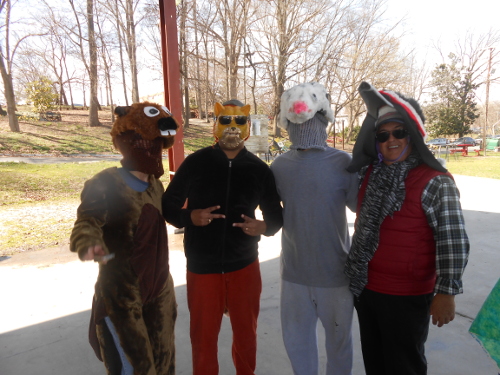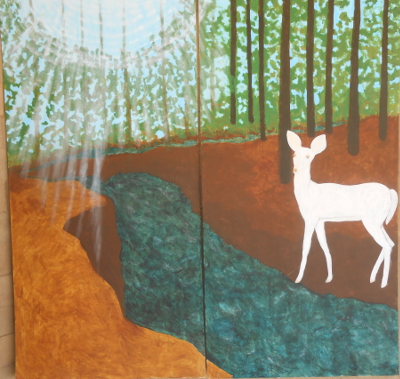
Durham Creek Week Kickoff features Northeast Creek Critters and Puppet Theater
The 2015 Creek Week Kickoff at Durham Central Park on March 21, 2015 saw the creek critters from Northeast Creek march in the parade with people from the other watersheds in Durham County.
One of the highlights of the event was the Northeast Creek Critter Puppet Theater featuring Woodrow the beaver and Clyde the raccoon and puppeteers Barry Archer and John Apel.
The elms are flowering
This is an article I wrote for the February issue of the Parkwood Inside/Out. We are planning trash cleanups on March 28th and a hike, and will be participating in the costume parade downtown on March 21st and other events for Durham Creek Week 2015. Check this website for announcements and all events will also be posted at:
Parkwood’s elms are blooming
Red maples dotting the still bare landscape with blots of crimson are one of the first signs that spring is here, but elms are among the first trees to flower. These prominent trees might be less appreciated because an elm in flower is stormy grey or lime green. Winged elms are the most common species, especially in central Parkwood, but there are slippery elms along the streams and probably American elms, and there are scattered Eurasian ornamentals. The most prominent and beautiful elm I know of in the area is the classically fountain-shaped tree on Highway 54, across from . Because its limbs are all high above the ground, it is hard to identify the species.
Elms, especially American elms, are beloved for the fountain or vaselike shape of mature trees, and there is a graceful symmetry to elms generally. Their leaves and branches alternate, creating an airy lattice effect. The straight veins in their oval leaves, double toothed like a pruning saw, are straight and parallel, but elms also have a very unsymmetric feature – the leaf bases are lopsided, especially in American and slippery elms. Elms have thin, elegant branches, strengthened by very tough wood, and the bark of some species can be twisted into rope. They produce wind pollinated bisexual flowers in early spring, developing into small seeds with a circular flange that drift with the wind several weeks later. The elms generally like moist soil, but winged elms seem to grow in drier soil as well.
The massive, spreading elm in front of Carrboro’s Town Hall could be an American elm (it is big enough for a plaque, yet nothing identifies the species), and I think there are labelled American elms in the Coker Arboretum at UNC. American or white elms are around, but are less common after the arrival of Dutch Elm Disease, a fungus that came to the US around 1930, and is spread by introduced and native beetles that bore in elms. Many elms have been killed, especially American elms, but this seems to be a little less catastrophic than the introduction of chestnut blight and emerald ash borer beetles, and the disease can be managed. American elms are large trees with furrowed bark, brownish leaf buds, and their leaves and stems aren’t very hairy, or less so than slippery elms. Their seeds have some hairiness, while the seeds of slippery elms lack hairs. Both American and slippery elms have large, sandpaperlike leaves, but American elms have greenish flowers, unlike slippery elms. Because their wood is so strong and resistant to splitting, and grips screws tightly, American elms have been used to make things like sports equipment, boats, flooring, crates, and kitchen cutting blocks. Many were planted for landscaping in the northeast, though they grow throughout the eastern USA. In A Natural History of Trees, botanist and nature writer Donald Culross Peattie wrote “If you want to be recalled for something that you do, you will be well advised to do it under an [American] Elm – a great Elm, for such a tree outlives the generations of men; the burning issues of today are the ashes of tomorrow, but a noble Elm is a verity that does not change with time. And although Elms too are mortal, great ones are remembered as long after they are gone as are great men.”
Slippery elms are similar to American elms, but smaller and less vaselike. They have been called red elms, having hairy, reddish leaf buds and reddish flowers, as well as hairy twigs. Their inner bark is slippery and becomes mucouslike when chewed. This inner bark was used to make tea and flour and was used for a variety of internal and external problems and still has an FDA approved medical use. American elm bark was used medicinally by Native American groups.
Winged elms are named for the cork flanges that line their twigs to varying degrees. Sweetgums usually aren’t as winged as elms and their leaves are very different. Winged elms leaves are smaller, smoother, and more symmetrical than those of other elms, and large trees have light brown bark. I think these are the first elms to flower, with brownish flowers that turn into silvery, hairy seeds. As with most trees, winged elms grow a lot when they first leaf out in spring, delicately etched leaves surging forth from the twig tips at a fast clip. The tiny, silky looking new leaves hang as if limp, but are actually strangely stiff. Snow, ice, and maybe hurricanes smashed many of the spindly young loblollies behind the Fire Station around 2002, leaving winged elms, ash, and a few surviving pines as the dominant tall trees, to be replaced themselves by oaks, hickories, and beech in coming decades.
Many animals chew on elm branches, leaves, and seeds, including opossums, rabbits, and bobwhites. The caterpillars that fed on elms are like a who’s who of moths and butterflies, including many of the moths you might see at your porchlights this spring. Double-toothed prominent moth caterpillars feed only on elms. They bite into a leaf and then rest there, so their jagged backs appear like the missing leaf edge. It is surprising that this camouflage works, since elm leaves are emerald green, but the caterpillars are pale seafoam blue and green.
English Ivy: Coming to a woods near you
This is an article I wrote for the January issue of the Parkwood Inside/Out, serving the Parkwood community, next to Northeast Creek in southern Durham.
English Ivy: Coming to a woods near you
Now that Parkwood’s green areas are bare, the full extent of the English ivy problem is plain to see. In places behind Newhall, Euclid, Revere, and between Highway 54 and Euclid ivy thickly covers the ground, smothering native vegetation, including the next generation of canopy trees, creating what might best be called “ivy deserts.” A few native and non-native plants do sprout through the ivy, including poison ivy, but the spring beauties, trout lilies, bluets, pink wood sorrel, pussytoes, and other flowers and forbs that should gild the forest floor are excluded. Ivy might affect invertebrates living in streams flowing through an ivy-filled woodland and change the soil, because ivy has nitrogen-rich leaves, a vital plant nutrient. It can carry bacterial leaf scorch, which infects trees such as maples, elms, and oaks. Ivy vines thickly festoon trees, which might make them more likely to fall, though there is some controversy, and less able to get to sunlight.
Once in the canopy, ivy gets enough sun to flower and produce clusters of black fruits, which birds spread into new areas. In my yard there is some ivy kept under control in pots, but in the last 10 years a lot of ivy has crept in through seeding. Without pests or diseases, cold weather is probably the main factor limiting ivy here, by preventing fruit production and temporarily stopping photosynthesis, an advantage evergreen ivy has over deciduous plants. For this reason, ivy is not a major problem further north, but it is rampant in the Pacific Northwest.
As its name suggests, common or English ivy (Hedera helix) is native to the continent of Europe, as well as the Middle East and north Africa, but it was introduced here starting in the 18th century. In its native range it is kept in check and is a valuable food source for birds, some of the species that have become problematic introductions here, such as European starlings and house sparrows.
English ivy is in the same family as ginseng, so it is not a relative of poison ivy or Virginia creeper (in the cashew and grape families, respectively), but I thought it was related when I took a large cut stem and pressed it to my wrist to see what would happen, and my skin blistered, but less intensely than it would with poison ivy. I’m pretty sure it was an ivy stem, and not Virginia creeper, and some people do react to ivy, but from a different toxin than that in poison ivy.
Ivy has evergreen, palm-shaped leaves with three to five points in shade, but they become more lance-shaped in the sunny treetops. The vines appear hairy because of glue-producing roots, while vines high in the treetops lack roots. Stems can be almost a foot wide, and reportedly a 433 year old vine in Europe was more than 20” across. Ivy has tiny and inconspicuous yellowish flowers that appeal to insects with a short proboscis, such as flies, wasps, and moths. The resulting fruit, technically called a drupe, contains a few hard seeds and a toxic glycoside that sickens humans and can make birds vomit. Still, the fruits are nutritious and fatty, and are often eaten by robins, mockingbirds, and cedar waxwings. As with some other non-native plants, human disturbances, such as new roads, give ivy inroads into new areas. There is a lot of ivy in Parkwood now, but it is rare or nonexistent in intact woods nearby. Livestock and deer can apparently eat the leaves, but don’t appear to be making much of a dent in the problem. Non-native rats might be the main animal that can use an ivy desert.
Other than landscaping, people have used ivy for its antifungal and antibacterial properties and in dyeing, tanning, and varnish resin.
Controlling English ivy and other non-native plants is a good New Year’s resolution. Many non-natives can be grown without causing too much trouble for native vegetation and the neighbors. There are more controllable non-natives, such as the groundcovers Vinca minor and Vinca major (they are similar, but V. major is larger and possibly more difficult to keep in check), which only spread vegetatively, but they spread a lot in shade. There are also many native alternatives. Crossvine is an evergreen vine with showy spring flowers that attract hummingbirds. Yellow jessamine is also evergreen and showy. Virginia creeper is a pretty deciduous vine with red fall foliage and dark blue berries. There are several evergreen groundcovers, such as doghobble, Galax, and partridgeberries (common in Parkwood).
Explore the bamboo grove
Michael and Derek are planning a walk through the bamboo grove near Euclid Avenue in Parkwood this Sunday, Jan 18 at 3 p.m. Join us as Michael begins to identify and catalog flora and fauna of the 1.5 acre grove.
Parkwood Christmas Parade – 2014
Northeast Creek Streamwatch put a unit in the Parkwood Christmas Parade again this year. Here are some pictures.
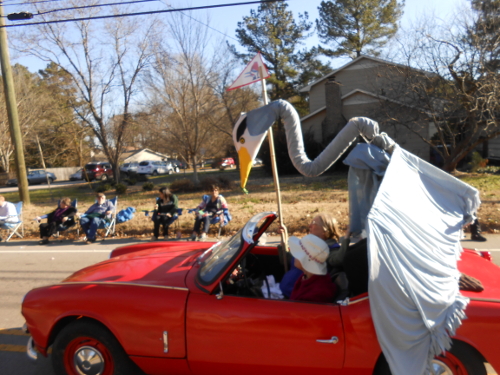
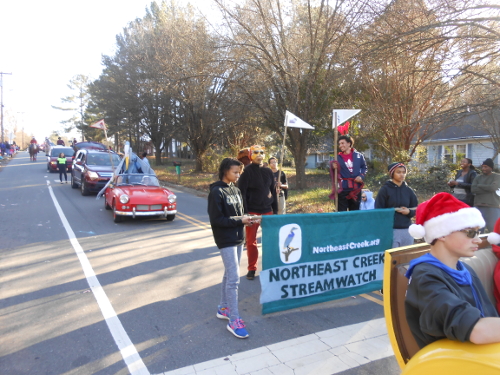
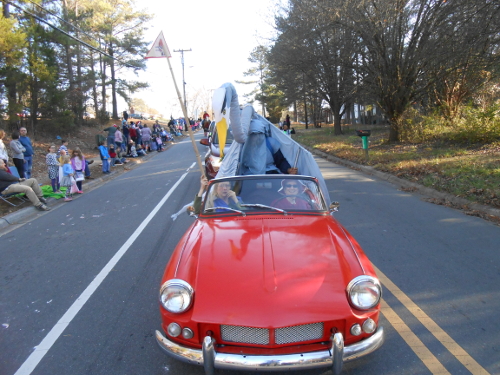
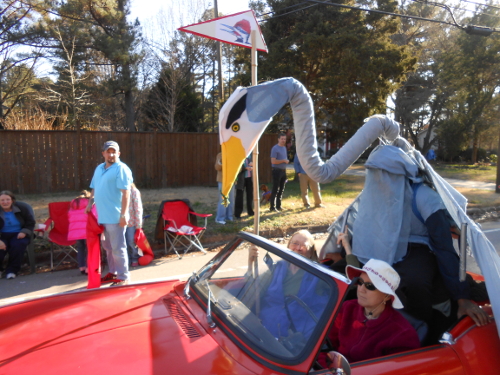
Stream and bamboo cleanup
NECSW is actively participating in the volunteer effort to manage the Parkwood bamboo grove and clean up the Euclid stream. Our vision is to manage the bamboo grove to create a productive and esthetically pleasing public space. A healthy grove is uniquely beautiful, is a good habitat for birds, reduces rainwater runoff from surrounding land, and offers a pleasant parkland for walking and contemplation. Three of our members joined six other volunteers for several work sessions this past week.
Fish to watch
This is from the June issue of the Parkwood Inside/Out. It might be past time for some of the behaviors described, but all summer the daily lives of fish are easy to observe, or easier than in winter.
Our next meeting is scheduled for July 13th at 3pm at the Parkwood Volunteer Fire Department. [The meeting has been moved up Seaton Road to the Parkwood Village Pool.]
NECSW was represented at a community consultation in June about a proposed apartment development at the intersection of 54 and Revere Road, but no neighbors attended.
Fish to Watch
June is a good time for fishwatching in the many waterways in Parkwood, as many species enter shallow water to spawn, often in bright breeding colors and exhibiting complex behaviors.
In Parkwood Lake there are swirling black masses of cute baby catfish, guarded by their parents, camouflaged in the murky water. The babies, or fry, are tadpolelike, with big heads and fins, but short tails. They are a species of bullhead catfish, probably black bullheads. In summer a pair swims in circles to excavate a round nest among plants or under a log. The parents guard their many eggs for the few days until they hatch and then stay with them until they grow to about two inches. Later in the summer light-colored fry can be seen darting alone over the bottom to deeper water when a person approaches the shoreline. When caught, bullheads hold their front pectoral and dorsal fins rigid, exposing sharp spines. Small madtom catfish inject painful venom through these spines. Bullheads grow to around a foot and a half long, but the Lake’s channel catfish can grow to around four feet. Channel catfish are grey, slender, and have sharply forked tails. Both channel catfish and black bullheads were probably introduced to this part of North Carolina from the Mississippi River basin.
The nests of sunfish species honeycomb the shoreline of the north Euclid Pond. There are many species, often lumped together as panfish or bream, but these fish are probably bluegills and/or pumpkinseeds. Their colors are hard to see in the water, but bluegills are blueish with stripes and males have red throats now while pumpkinseeds are reticulated with orange and blue. Most sunfish have a black opercular lobe behind the eye, and this is plain black in bluegills, but bordered with orange and white in pumpkinseeds. Males use the motion from their fins to create nests, where they court females. Smaller males try to get in to fertilize the eggs by mimicking females or sneaking in when the owner is distracted. Males guard the eggs and fry until they leave the nest. Sometimes sunfish will even nip at feet placed close by, if they don’t know a human is attached! Surprisingly large sunfish can live in Piedmont brooks and in summer sunfish travel far upstream from the Lake. Largemouth bass are a species of sunfish, and they create correspondingly large, isolated nests.
The minnow family, the biggest family of fish, seems more abundant in clear rocky streams than in suburban lakes, but there are some species in Parkwood. Common carp are gold-colored minnows with short barbels on the corners of their vacuum-like, down pointing mouths. There are carp three feet long in the Lake. To breed, groups of one or a few females and several males enter weedy areas and carry on with splashing and jumping. Carp were introduced from the Old World as a food fish. Japanese koi are colorful, long-lived, and sometimes expensive domesticated carp. Carp tolerate poor water quality and are eaten by predators like otters in Northeast Creek, but they degrade habitat for native fish by uprooting aquatic vegetation and muddying the water. In late summer large carp can be seen gulping at the surface of deep pools in the Creek, such as below the American Tobacco Trail bridge. There are or were large goldfish in Parkwood Lake. Wild goldfish are drab and can grow over a foot long. They are non-native and can hybridize with carp. Small shiners, of which there are many native species, can be found in Northeast Creek and possibly in Parkwood Lake.
The Lake’s ever-present, nondescript grayish “minnows” are actually mosquitofish, Gambusia affinis, basically a wild guppy, and have black spots and a neon violet sheen up close. The large females have a large black spot and give birth to live young. If you look closely, their mouths are turned up, to pick off insects such as mosquito larvae, breathing at the surface. The Lotus Pond doesn’t have much flow in the summer, so some guppies are afflicted with a white fungus on their fins.
In nearby weedy beaver ponds, if not in Parkwood Lake, there are toothy bowfin, also called dogfish, living fossils that can breathe air and make bass scatter. Males guard schools of young until they grow to about four inches. It would be cool to see a prehistoric-looking longnose gar, but I have only heard of them being seen at Westpoint on the Eno and maybe in north Raleigh. Chain pickerel with ducklike snouts also lurk in weedy beaver ponds and wetlands. Pickerel are lunging predators, cylindrical, with fins set far back, so they can dart out at prey. On the other hand, sunfish have a pan-shape that lets them catch small prey up and down the water column. Shoals of filter-feeding shad sometimes ruffle the surface of Parkwood Lake. In Northeast Creek there are many small species, such as darters and mudminnows.
Get to know some local pines
This is an article I wrote for the April issue of the Inside/Out. The loblolly pines are done ‘flowering,’ but yellow jasmine is still blooming in pinewoods and there is more to see under the pines.
Parkwood under the pines
I used to discount the pinewoods that are so abundant around here as pretty dull and barren, but pines can grow on you. This month the sky will be hazy with clouds of pollen (winged, like the seeds) for about two weeks, much of it probably wafting from loblolly pines. Their glistening needles seem so green in the intensifying sunlight, before the softer greens of hardwoods emerge. There are three or four pines native to Parkwood and another two that aren’t quite native.
The most abundant pine is the loblolly pine, Pinus taeda (taeda refers to torches). Their seeds sprout wherever there is bare, sunny ground, but loblolly probably refers to temporary puddles. Loblollies have relatively long needles, usually three in a fasicle, a bundle of needles that is actually a tiny branch, and rough dark gray and reddish bark. The cones are large and prickly. Most of Parkwood’s pines are still relatively small, but loblollies can grow 115′ tall, five feet across, and live more than 200 years. There used to be some around three feet across behind Racliff Circle, and there are still some very large pines on low ground by the Ball Field and behind Ace Hardware.
Shortleaf pines are common, but their ranks are much fewer than the loblollies. Shortleaf pines usually grow on hills and have short needles, two or three to a sheath, the smallest cones, and smooth brownish bark furrowed into large rectangles. They have small, but spreading dark green parasol-like crowns, reminding me of a Japanese painting, supported by sturdy, angular branches. Unlike loblollies, shortleaf stumps can re-sprout when young. Shortleaf pines can grow up to 150′ tall and 3-4 feet across, and like loblollies are an important timber tree. Their scientific name is P. echinata, probably referring to the hedgehog-like spines on their cones.
There are a few Virginia pines (P. virginiana) around, but they are more common west and north. They are also called scrub pines and often form thickets of small trees, though they can get 60′ tall. The needles come in twos, and curl. The cones are small and cling to branches years after the seeds have all fallen out. Overall they have a bristlely appearance with weathered and broken old branches and flakey brown bark, but their airy branches arch gracefully. There are a few behind Parkwood Elementary’s ballfield.
Pond pines resemble loblollies, but have slightly shorter needles on easily broken twigs and small, round, and not very prickly cones. There might be some around here, but they are more common east. They are called pond pines because they like moist ground and their scientific name, P. serotina, meaning late, probably refers to how the pinecones are held for years. Virginia pines and pond pines aren’t often cut for wood.
North Carolina’s state tree, the longleaf pine, is typical of the Sandhills and might never have grown in Parkwood naturally. They have needles so long they are woven into baskets and saplings have a strange, grasslike form. Longleaf pines are adapted to survive fires, so they form pine savannas when periodic fires are allowed to burn, killing the hardwoods. These majestic pines aren’t limited to wet soil, but P. palustris refers to marshes.
Eastern white pines are common Christmas trees and can last at least several years if planted here, though they are native to the Appalachians and north, where old growth trees grew over 200′ tall. They do grow naturally in one spot nearby, the White Pines Preserve in Chatham County ( triangleland.org/what-we-do/nature-preserves/white-pines-nature-preserve ), where they found shelter on a north-facing slope along the Deep River after the ice ages. White pines have soft bluish needles coming in fives and unusual long thornless cones (and they are called P. strobus, strobus meaning pinecone). The branches form whorls around the trunk. White pines are cut for timber, but are softer than southern yellow pines like loblolly.
Pines are a prominent feature of the landscape because they are among the first trees to grow. Loblollies are the main pioneering pine around here, sometimes with shortleafs, and Virginia pines are first in other places, often on bare clay. These pines can’t stand shade, so if not disturbed by logging or fire, hardwoods eventually take over. Some flowers are common under the sighing and creaking pines. The flowers of yellow jasmine vines bedeck pine forests now. I have often found rare pink ladyslipper orchids shaded by pines [these flower in May], as well as downy rattlesnake plaintain (another orchid), yellow-eyed grass, Pipsissewa, pencil flower, and wild roses. Brown-headed nuthatches, talkative little birds that sound like squeak toys live in pines, as do pine warblers, and birds of prey nest there. On hot, dry days of late summer, the raspy, treefrog like calls of Robinson’s cicadas often resonate out of pines. Around the same time, it becomes hard to walk barefoot under the pines, because squirrels sit in favorite branches to eat green cones like corncobs and rain down thorny scales.
Notices: We met April 13th and our May meeting will be next Monday, the 5th, at the Mediterranean restaurant in the Parkwood Shopping Center, time TBA.
This week we are looking at the umbrella magnolias and pinxterflower azaleas, but see the listserve for those announcements.
Durham Creek Week 2014 – Clean Up Parkwood Creek
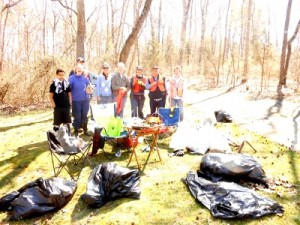
Ten volunteers (eight seen here) in three hours cleaned out six bags of trash on Parkwood Creek between Seaton Road and the Lotus Pond on Clermont. Objects recovered from the creek were a couple of small tires, a well-weathered kickball and small football, a length of twisted guywire, and a bent metal table leg.


